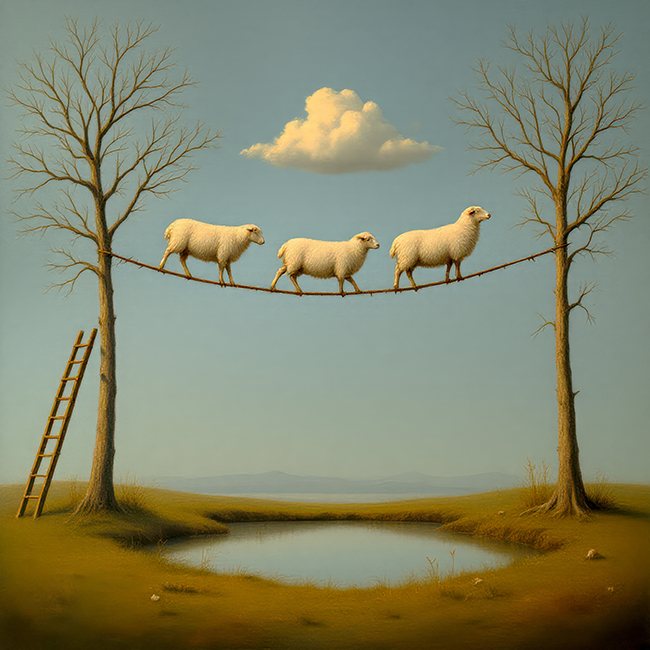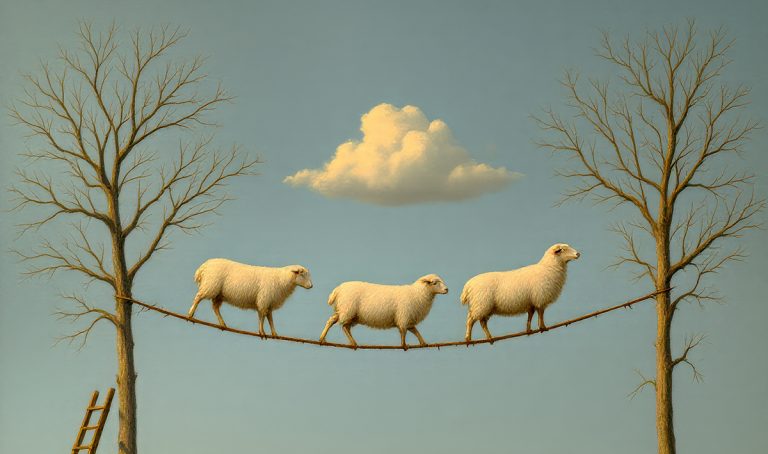Alan Brown’s journey into art began in the quiet of a darkroom. It was there, watching photographs slowly appear under the red light, that something clicked. The process was slow, physical, and quiet — and it left a deep mark. That early moment wasn’t just about learning a skill. It was about seeing differently.

That first experience launched a career that has now stretched across four decades. Brown earned his BS in Communications at Syracuse University, concentrating on Advertising Photography and adding a minor in Art History. It gave him both a technical and historical grounding — one eye on the craft, the other on the story behind the image. Over the years, his work evolved, moved, shifted — but his obsession with the line between what is real and what is imagined has remained at the heart of everything he creates.
Brown’s work today hovers between the surreal and the intimate. One piece, The Crossing, Series 1, II, captures this approach well. It’s a quiet image — three white sheep delicately balancing on a rope tied between two stark, leafless trees. Below them, a calm pond mirrors the scene. Above, a single cloud floats in an otherwise empty sky. There is no action, no storm, no drama. Just stillness. And tension.
It’s whimsical, but also a little unsettling. That’s the line Brown likes to walk — just like his sheep. His images are often anchored in the recognizable: a landscape, an animal, a tree. But from that familiarity, he pulls something else — a question, a pause, a twist. He turns the everyday slightly askew, and in that tilt, meaning opens up.
There’s a strong connection to NeoSurrealism in his work, but he doesn’t use that as a crutch. Instead, he treats it as a starting point — a way to get at what can’t be said plainly. He’s interested in the in-between places: between memory and present, between ordinary and dream, between real and imagined.
Brown’s process reflects this search. He builds his scenes with care, sometimes digitally, sometimes through a mixed-media blend of photography, illustration, and collage. But the effect is never loud. His palette is muted. His compositions are calm. Even when the image is strange, it whispers rather than shouts.
There’s a sense of solitude in much of his work. Not loneliness — just quiet. Like walking into a room after someone has left. You’re not alone, exactly, but you’re aware of what’s missing. That feeling — hard to name, hard to pin down — is what gives his work emotional weight.
In The Crossing, the sheep aren’t just sheep. They could be stand-ins for people, ideas, memories. They are out of place, doing something improbable. And yet, there’s no panic. They move carefully. The rope holds. The trees, though bare, are steady.
Brown seems to be asking: What happens when we move through strange terrain? Can we trust the path, even when it seems absurd?
That quiet push toward reflection is something he returns to again and again. He’s not interested in spectacle. He doesn’t chase trends. His images are slow — not in execution, but in how they unfold. You look once. Then again. And something different surfaces each time.
After four decades, Brown’s work hasn’t lost its sense of wonder. In fact, it may have grown stronger. His eye has sharpened not just in what it sees, but in what it chooses to show.
There’s a calm confidence in his recent pieces — like someone who knows the terrain of the strange, and doesn’t need to explain it. He simply invites you in. And if you accept, you might find something you didn’t know you were looking for.
A memory. A question. A moment of stillness.
Or maybe just three sheep, walking a rope across the sky.


